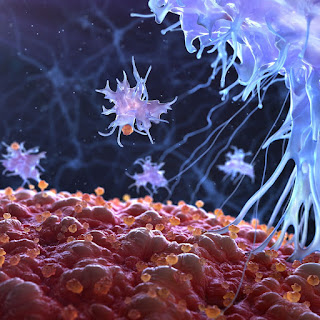The regulation of rapidly transforming stem cells into trophoblasts and expanding embryonic cell phenotypes, between gestation day 8 and 15 is fast and furious. Research unraveling the finer detail points to the advent of pressure impacting evolving conditions for growth, transformation of cells, microvasculature and resulting tissue types. Notably, Natural Killer (NK) cells expand to around
30% of the cells in the stroma of the uterine wall. These uterine NK (uNK) cell subsets coexist alongside
conventional NK cells. This unusual uNK quantitative imbalance motivated our research.
uNK are closely associated with spiral artery remodeling, for placentation at the blastocyst implantation site. They possess a functional Renin- Angiotensin system (RAS), the cornerstones of blood pressure. The ratio of uNK cells expressing Angiotensin II receptor type 1 (AT1) markedly changed between gestation day 6 and 10. At day 10-12 Atrial Natriuretic Peptide, for vasoconstriction and dilation, strongly co-localized to uNK cells at the implantation sites. Expression of these vasoregulatory molecules by uNK suggests they contribute to the changes in blood pressure that occur between days 5 and 12 coincidental with their population explosion in the decidua during normal pregnancy.
Similar to Angiotensin, Bradykinin (BK) is produced from an inactive pre-protein kininogen that is activated by serine protease kallikrein (KLK), mostly represented on chromosome 19, where they associate with a
number of other genes involved in blood pressure. Oakridge scientists predicted that BK induced a Covid19 "
cytokine storm" that is responsible for disease progression.
KLK's are located at 19q13.41, an active transposon region with a 2x background deletion rate clustered near Zinc Fingers and KIR's (Killer immunoglobulin like receptors) that inhibit NK cells. A link was confirmed in mice uterine NK cells that regulated local tissue blood pressure, by at least AT1, partly in response to mechanical stretch of vasoconstriction and dilation induced by uterine NK's internal RAS.
In reproduction, at Chromosome 19 MiRNA Cluster (C19MC), 59 known miRNAs are highly expressed in human placentas and in the serum of pregnant women. Numerous C19MC miRNA's are also found in peripheral blood NK's and at least miR-517a-3p (a C19MC from fetal placenta) was incorporated into maternal NK cells in the third trimester, and was rapidly cleared after delivery. miRNA's also regulate the migration of human trophoblasts and suppress epithelial to mesenchymal transition (EMT) genes that are critical for maintaining the epithelial cytotrophoblast stem cell phenotype.
In hepatocellular carcinoma (HCC) a co-regulatory network exists between C19MC miRNAs, melanoma-A antigens (MAGEAs), IFN-γ and p53 that promotes an oncogenic role of C19MC and is disrupted by metal ions zinc and nickel. IFN-γ plays a co-operative role whereas IL-6 plays an antagonistic role. Its an important immunoregulartory network, because, in the very least, IFN-γ and IL6 have a major baring on the expression of HLA/MHC molecules on cancer cells.
Immediately adjacent to C19MC, is the leukocyte immunoglobulin-like receptor complex, from where LILRB1 receptor, also known as Mir-7, is expressed on NK cells. It binds MHC class I molecules, on antigen-presenting cells and transduces a negative signal that inhibits stimulation of an immune response. LILRB1 has a polymorphic regulatory region that enhances transcription in NK Cells and recruits zinc finger protein YY1 that inhibits p53. It is required to educate expanded human NK cells and defines a unique antitumor NK cell subset with potent antibody-dependent cellular cytotoxicity.
In 2019 a study of arsenite-induced, human keratinocyte transformation demonstrated that knockdown of m6A methyltransferase (METTL3) significantly decreased m6A level, restored p53 activation and inhibited phenotypes in the-transformed cells. m6A downregulated expression of positive p53 regulator, PRDM2, through YTHDF2-promoted decay of mRNAs. m6A also upregulated expression of negative p53 regulator, YY1 and MDM2 through YTHDF1-stimulated translation of YY1 and MDM2 mRNA. Taken together, the study revealed the novel role of m6A in mediating human keratinocyte transformation by suppressing p53 activation and sheds light on the mechanisms of arsenic carcinogenesis via RNA epigenetics.
In 2021 a discovery that YTHDF2 is upregulated in NK cells upon activation by cytokines, tumors, and cytomegalovirus infection. YTHDF2 maintains NK cell homeostasis and terminal maturation. It promotes NK cell effector function and is required for IL-15-mediated NK cell survival and proliferation by forming a STAT5-YTHDF2 positive feedback loop. Analysis showed significant enrichment in cell cycle, division, including mitotic cytokinesis, chromosome segregation, spindle, nucleosome, midbody, and chromosome. This data supports roles of YTHDF2 in regulating NK proliferation, survival, and effector functions.
As part of the 2021 discovery, transcriptome-wide screening identified TDP-43 to be involved in cell proliferation or survival as a YTHDF2-binding target in NK cells. TDP-43 induces p53-mediated cell death of cortical progenitors and immature neurons. Growth of the developing cerebral cortex is controlled by Mir-7 through the p53 Pathway
Here we have broadly described mechanisms by which NK cells maintain tissue homeostasis where tightly regulated p53 optimizes cellular conditions to 'self' educate the expanded NK cells. Those that express NKG2A and/or one or several KIRs, for which cognate ligands are present, become educated and as such transform to potent killers in response to their missing-self. Therefore, p53 isoforms have the innate capacity to promote a cellular homeostasis that makes it the mediator for optimal education of expanded NK cells.




